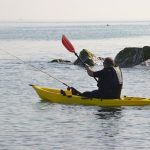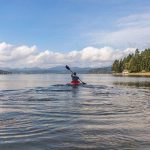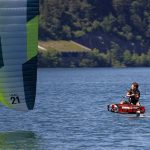The Walton County flag system uses the colors established by the Florida Department of Environmental Protection to warn swimmers of conditions in the surf. If you see a red flag, that means the water is too deep to safely stand in–you should only go in up to your knees.
When double red flags are flying, that means the water is closed to swimming entirely. The purple flag is added when there are jellyfish present in the water.
You can check the current flag conditions at www.swfd.org.
What Do All These Beach Flags Mean?
More than likely, you have seen these flags while spending a day at the beach. They are typically located near the surf, close to lifeguard towers.
The colors on the flags vary, with green, yellow, red, and sometimes purple being the most common colors. So, what do all of these colors on the beach warning flags represent?
This guide covers the different types of beach warning flags. It’s important to know the types of flags before going to the beach so you can be safe in the surf and plan accordingly.
The United States Lifesaving Association and International Life Saving Federation have specific guidelines for beach safety flags. There are only a few flags to remember.
Now that we know the types of flags, let’s go over some additional beach safety guidelines and signs.
Types of Beach Warning Flags
Yellow
The yellow flag indicates that the surf conditions are moderate and presents a medium level of hazard. This could mean that the waves are rough, there are large waves, or there may be a small rip current.
In yellow flag conditions, we recommend that adults should always supervised.
In addition to wearing life vests, if you’re taking your kids out in the water, always take along a lifeguard.
If you see a yellow flag, it means that the conditions are not ideal for swimming. Be careful if you decide to swim in this type of environment.
Red
A red flag means that the surf is very dangerous. The reason could be huge waves, strong rip currents, or other dangerous conditions.
Do not go into the ocean when the red flag is up unless you are a strong swimmer.
Never swim alone, and be extra careful if you have to swim when the red flag is up.
A red flag indicates a high hazard according to the ILSA.
Red Flag Over Red Flag
If you see a red flag over another red flag, it means that the hazard is extremely high and the water is closed to public use.
The flag type is only for the most dangerous surf conditions and we recommend not going into the waters when the flag is displayed.
You should never go into the water when there are double red flags.
Green
A green flag is the opposite of a red flag, which indicates calm surf conditions.
Today is a good day to go to the beach because it is safe.
If there are no other flags present, it is safe to use surfboards, bodyboards, and any other type of watersports gear. Just be safe with other riders and beachgoers.
While beach days are fun, it’s important to be careful and watch your children closely.
Purple
If you haven’t seen a purple flag, it means that there are marine pests in the area.
What is a marine pest, exactly?
A marine pest could be a plant, like algae, or an animal, like a jellyfish or shark.
A purple flag means that there may be harmful jellyfish in the water and swimming is at your own risk. Talk to your lifeguard before entering the water to find out what kind of dangerous marine pests are present.
We strongly advise against going into areas with a purple flag warning, as a jellyfish sting from a dangerous jellyfish can be fatal.
Red Flag Over Yellow Flag
Unlike the other flags, the red over yellow flag does not mean something is dangerous. This flag represents an area where swimming is recommended and there is lifeguard supervision.
The safest place to swim at the beach is between the red and yellow flags. Although it may be more crowded, your safety is more important.
Black and White (Or Quartered)
The black and white area designated for watercraft should be avoided for swimming if possible.
These areas are reserved specifically for surfing. The waves and other conditions are perfect for surfing at these areas, and the flag is a warning to non-surfers to stay out of the area so that both surfers and people on the beach can stay safe.
Yellow Flag With Black Ball
You will see a yellow flag with a black ball or circle in the middle to indicate that watercraft use is prohibited.
Do not surf or use any watercraft in these areas.
Orange Windsock
A windsock that is orange in color indicates that there are offshore or strong winds present.
If there is an orange windsock on your beach, that means that the winds are too strong to be using any type of inflatable or float.
Red and White (Or Quartered)
The red and white quartered flag is a sign that you need to evacuate the area immediately.
There are many possible explanations for this, such as sharks in the water or hurricane conditions.
Evacuate the water immediately.
Beach Safety Tips
Supervise children and young adults at all times
It is important for children and young adults to always swim with an adult supervisor.
Swim With a Buddy
If you’re going to be swimming, surfboarding, or bodyboarding in the ocean, always go with a buddy. This will help ensure your safety if you ever find yourself caught in a rip current or big wave.
Swim at Lifeguard Beaches or Near the Lifeguard Post
If you want to be safe while swimming, surfing, or boarding, you should go to a lifeguarded beach and stay in the designated area. If you’re surfing or boarding, make sure to go under a black and white flag. If you’re swimming, stay within the area bounded by red and yellow flags.
For Rip Currents
Swim parallel to the shore if you come into contact with a rip current and feel confident you can swim. Do not try to swim directly inward or you’ll be pulled further in.
If you’re not confident in your ability to swim, you should call for help from the lifeguard or nearby beachgoers.
If you don’t want to end up in a rip current, make sure to pay attention to the flags and signs that lifeguards put up, and listen to what they tell you.
How to Identify a Rip Current
Darker color surf, indicating deeper water
The water is murky brown because sand has been stirred up from the bottom.
, produce a foaming, creamy white water called `whitewater.’ The smaller, unorganized waves alongside the more evenly breaking waves over a sand bar produce a foaming, creamy white water called `whitewater.’
The waves are breaking further out to sea on both sides of the rip current.
How to Help Someone Caught in a Rip Current
- Find a lifeguard
- Call 911
- Do not enter the water, you will get caught in the current
- Throw a flotation device
- Don’t lose sight of the victim
What To Do If You Are Caught in a Rip Current
- Don’t panic or swim against the current
- Relax and float with the current until it weakens
- Swim parallel to shore and back in
- Go to an Access With a Lifeguard
The Visit South Walton Safety Program funds lifeguards who are present at the beach to provide added safety for beachgoers.
There are lifeguards at different beaches in South Walton from 10 a.m. to 6 p.m. These beaches also have parking lots and restrooms.
Walton Beach Rules and Safety Information
The Walton County flag system uses the official colors established by the Florida Department of Environmental Protection to signify different surf conditions. Red flags mean that the water is too deep to safely stand in, so cooling down is limited to the edge of the water.
When double red flags are flying, the water is closed for swimming. The purple flag is added when marine pests are present and swimmers should watch out for jellyfish.
Current flag conditions are posted at 9 a.m. and 1 p.m. daily at www.swfd.org.
Do Not Dig Holes More Than a Foot Deep
Each year, children suffocate to death after crawling into tunnels or holes that collapse on them. Parents should fill in any holes their children make at the beach, as small holes can be just as dangerous.
Not only can holes injure people walking on the beach at night, but they can also trap and kill sea turtles trying to nest.
Tips for Beach Safety
- Don’t dive into the gulf (2/3 of catastrophic neck/head/ spinal injuries occur in open water and the sea)
- Know before you go (know the meanings and obey the flag warnings)
- Knee deep is too deep on red flag days
- Take frequent breaks (every hour take a sun, bathroom, or water break)
- Look but don’t touch (call local authorities to help injured/stranded animals)
- Go with the wind (individuals, especially children, tend to take the course of least resistance—follow the wind to find someone who is missing from your group)
- Be cautious and swim close to shore
- If you see lightning, leave the beach immediately
Beach Of South Walton Rules
- No glass containers on the beach
- No littering
- No swimming or wading on days when a double red flag is flying
- No dogs on the beach, unless resident with a valid permit during approved hours
- No vehicles on the beach, except within a designated area in Grayton Beach for residents with a valid permit
- No camping on the beach
- No excessive noise
- No open fires on the beach without a permit
- Removal of sand or water from the beach is strictly prohibited
- No weddings or events on the beach without a permit
- Personal belongings left on the beach overnight will be removed and discarded
- No tents larger than 10′ x 10′ on public beach
- No charcoal grills are permitted on the beach, propane grills may be permitted if 16″ x 20″ or smaller.
- Removal of sand, water, or vegetation is strictly prohibited.
- Keep off the Dunes. Dunes take a long time to build. They are both fragile and strong. Dunes are critical for protecting our environment and property.
Federal Regulations
If you find a marine mammal that is sick, injured, or dead along the beach, you should call the Southeast Region Stranding Network 24-hour hotline at 877-WHALE HELP (877-942-5343) or Emerald Coast Wildlife Refuge at 850-650-1880.
- Respect wildlife
Observe wildlife from a distance, especially nesting sea turtles.
- Be considerate of other visitors
Avoid loud music or noise—let nature’s sounds prevail.
- Don’t Leave Holes
Make sure to fill in any holes you dig, including those left from sticking poles and beach umbrellas into the sand. This will help to prevent injuries to others andyou won’t create obstacles for nesting sea turtles.
- Dispose of trash properly
Please use one of the 470 trash receptacles provided along the beaches for your trash, cigarette butts, and other waste.
Beach Bonfire Guidelines
A permit is required to have a bonfire on the beach, including a fee. The SoWal Fire District provides permits and guidelines for having a bonfire on the beach.
Observe & Protect Our Natural Environment
- Bring a bag to collect trash when walking along the beach
- Be sensitive to nesting turtles and birds • Use turtle-friendly flashlights when walking along the beach at night (flashlight covers are available at the TDC Visitor Information Center) • Leave the dunes undisturbed • Take an eco-tour with one of the area’s Nature-Based Certified Outfitters
Leave No Trace
The beauty of our area can only be maintained if we all work together to take care of it. We can do our part by being environmentally responsible and making sure we don’t leave any litter behind when we enjoy the area’s beaches, waterways, and natural areas.
This way we can help protect and preserve this destination for everyone to enjoy.




